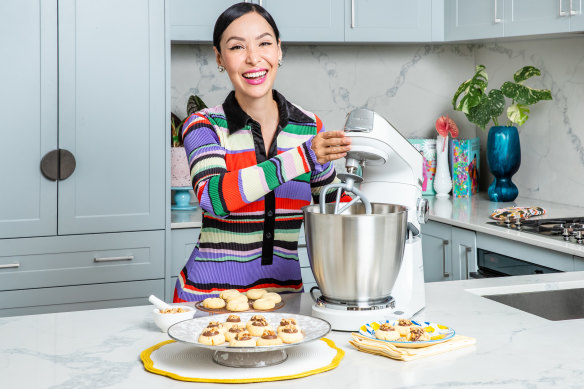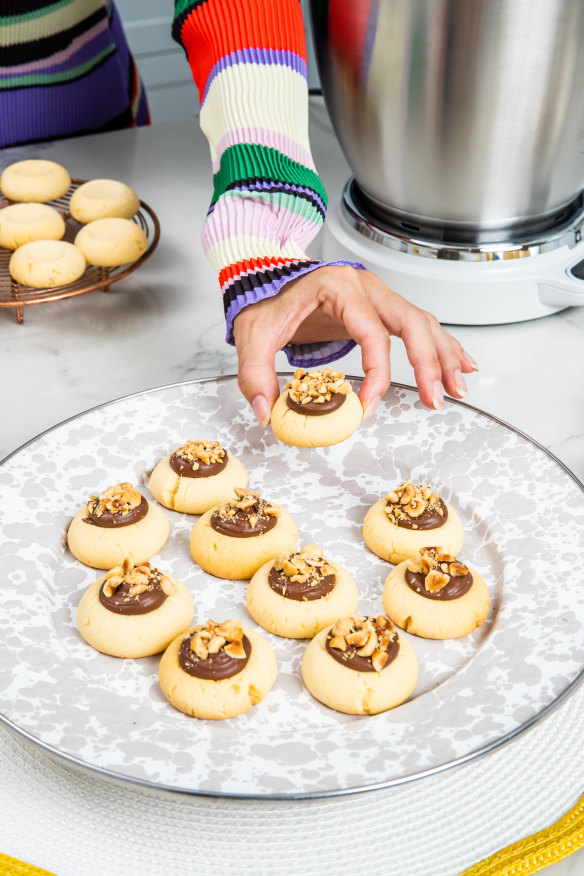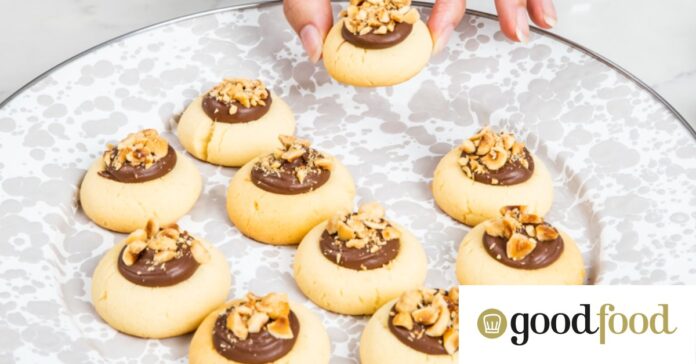[ad_1]
Miss your old mates, or need fresh ways to find new ones? Baking queen Katherine Sabbath shows how the social power of a handmade treat can work wonders.

With her vibrant outfits and colourful make-up, Sydney cake-maker extraordinaire Katherine Sabbath might seem like she’s always had an out-there personality.
So it might be surprising to hear she wasn’t the most sociable person growing up. A speech impediment and stutter made communicating tricky, Sabbath says, and she generally “wasn’t very comfortable in myself”.
It wasn’t until about age 15, when Sabbath started baking with earnest, that the self-described introvert discovered the social power of a handmade treat.

“I would bring cupcakes and chocolate brownies to school to celebrate friends’ birthdays, and that’s kind of where I developed my love for it,” she says.
“I saw how easy it was to make friends if you turn up to a party with a big tray of caramel slice. It’s so easy to make conversation with people and it’s such a great ice-breaker, but it also lets people know who you are as a person without really having to say much at all.”
Sabbath, an ambassador for Nutella and Kenwood, believes people who enjoy cake and baking tend to be “good people you want to keep in your life”.
“People who bake don’t often bake for themselves. It’s a fun and enjoyable thing but usually someone else is at the core of it and that’s a sign of a good heart. Not to toot my own horn. But I am a really nice person!”
Here, Sabbath shares 12 top tips for connecting with others through the power of baking.
Bake for anyone and everyone
Whether it’s a friend, neighbour or colleague, most people will enjoy slice of sweetness that’s specially cooked for them, Sabbath says. That’s probably because cakes aren’t everyday staple foods, and are literally a treat “in its truest sense of the word”.
So don’t overthink who you can cook for – most people will appreciate the effort you put in. “If one of my friends comes over to visit and they’ve baked me something, I love that so much and most of the time it tastes better than something I would have made for myself,” she says.
Tailor your baking
The beauty of home baking is you can create a completely bespoke cake with one particular person in mind. Think about what they do or don’t like, whether it’s fruity flavours, chocolate or something nostalgic.
You could put a special spin on a favourite recipe, dress up your bake with different flavours (see Nutella thumbprint cookies recipe below) or take their favourite ingredient and create something you can’t buy at the shops.
“[It’s about finding] something that they go nuts for, something that they really love, and turning that into a cake or turning that into a slice or brownie.”
You don’t need to limit your creativity to ingredients, either. Think about the way the person dresses or their taste in music, then incorporate that into your cake design.
“You can try lots of different things,” Sabbath says. “You can even pipe a pun on a cake, or a message to someone that makes them laugh.”

Bankable bakes
The most popular bakes tend to be smaller, snack-sized treats such as biscuits (especially choc chip), caramel slice, or lighter cakes such as a sponge with whipped cream and fruit.
You can’t go wrong with chocolate brownies, Sabbath says, and pavlova is a perennial favourite for lots of people, too.
Other easy options include mini cheesecakes or tart shells filled with lemon curd or cream cheese.
For something slightly less sweet, try making friands or something with a nut-meal base and stud it with raspberries.
Or create something citrusy such as lemon slice or lemon meringue pies.
Madeleines are a beautiful and easy option too, but you’ll need a special tin to bake them.
Let the cake do the talking
If you’re a quiet or introverted person and tend to feel nervous before a party, let your bake act as a conversation piece and use it as a way to introduce yourself rather than relying on the usual awkward small talk.
Not only does the cake take the attention away from you personally, it’s a natural way to draw people towards you who are curious to try a piece and talk about it.
“It’s a really easy way to make conversation with someone without being like, ‘So what do you do?’”
Don’t forget the practicalities
A spectacular cake might impress a crowd, but it’s not always the most practical option for many social situations, Sabbath says.
“A [show-stopping] cake is always … a really nice centrepiece and it’s a great conversation starter,” she says. “But you have to be there to cut and serve it, and the logistics of that can be a little bit laborious if you’re not ready for it.”
If you just want to put something down while you chat with guests, then a tray cake or a slice are easier options. Finger foods that aren’t too messy to eat such as mini tarts or brownies work well, too.
Ask ahead
It’s a good idea to check in with your host before bringing a cake to a party or event, Sabbath says. You don’t want to double-up on dessert, or bring something if there isn’t space to store it. “It’s like wearing white to a wedding. You just have to check, and definitely make sure you’re not stepping on anyone’s toes,” she says.
If they don’t need help with sweets, you can always offer to bake a something savoury such as a quiche. Similarly, be aware of any allergies or intolerances you need to cater for, and if you need to make any adjustments or alternative plans.
Bring back the cuppa
You don’t have to bake for a huge party or your whole office. Just dropping in for a quick cup of tea or coffee with a slice of cake is an easy and inexpensive way to connect with old friends.
“Bring a nice sweet loaf, something not too difficult to make, that you can whip that day or the night before,” Sabbath says.
Freeze and defrost
While you’re at it, make a second loaf or tea cake then pop it in the freezer, ready to thaw out any time someone drops by. “Usually the cake will be as good if not even better defrosted,” Sabbath says.
Anything high fat such as mud cake or buttercream freezes particularly well. “Buttercreams keep for months – [after defrosting] if you just use a paddle attachment in the Kenwood or a hand-held mixer they’ll whip together really nicely.”
Some cakes can even be eaten frozen, such as a brownies or caramel slice – both highly recommended on a hot summer’s day.
Don’t stress
Baking shouldn’t be stressful, so don’t push too far beyond your comfort level, and be realistic about how much time and energy you have to spare. Simple bakes are fine, preferable even – the final product just has to taste good.
“It’s meant to be fun, it’s meant to be relaxing,” Sabbath says. “As long as the food doesn’t go to waste it’s going to be appreciated, and it’s going to be a great bake.”
If you do want to try something a little more complex, then planning each step in advance and listing what you need to do each day will help reduce the stress.
“I’ll never just whip up a show-stopping cake unless I’ve already got the ingredients frozen and ready to go. Those wedding cakes and big birthday cakes – they definitely don’t just happen.”
Clever cheats
Freezing ahead isn’t the only trick Sabbath has up her sleeve. Softening or melting ingredients in the microwave is fine, as is using packet mixes if you’re pressed for time or electric mixers or beaters to whip meringue or cream. Basically, anything that makes cooking easier and more fun is OK.
“There shouldn’t be any snobbery with making something that essentially is just a really generous act,” Sabbath says. “As long as the food is being eaten, you shouldn’t feel like you’re being judged for making a cake a certain way.”
“It’s so easy to make conversation and it’s such a great ice-breaker, but it also lets people know who you are as a person without really having to say much at all.”
Katherine Sabbath
Don’t forget the transport
Moving your finished bake to its final destination can be the most stressful part of the process, especially if you’ve made a towering cake with layers of ganache or cream, Sabbath says.
She actually factors transportation into the design of a cake, taking into consideration if she’ll have time to assemble it on site or how far it needs to travel in the car and whether anything needs to be adjusted to make it more portable.
“The taller the cake the more likely it’s going to flip over,” she says. “You need something that’s going to be a bit sturdier when travelling.”
Transport tips
- Any box will do for the cake but if you’re using a cardboard one Sabbath suggests cutting one of the sides out then sliding the cake in and taping the side shut, to avoid lowering and lifting the cake out vertically (“that’s how you can put your whole palm in the cake”).
- Or if you’re using a large plastic container, turn it upside down and use the lid as a base, then place the container over the cake.
- Placing a non-slip mat under the cake box on your car’s passenger side floor or in the boot helps prevent it from sliding around or toppling over, too.
- Alternatively, a tray or sheet cake you can bake, carry and serve in a glass dish is a practical and portable option.
- Weather also affects Sabbath’s design and ingredients – whipped cream and uncooked eggs will usually be fine in winter but won’t be sturdy enough or safe to serve after a few hours on a hot summer’s day.
Mail it
Can’t deliver your cake in person? Send it in the post. Something sturdy and stable such as biscotti or shortbread dipped in dark chocolate is a lovely way to let far-flung friends know you’re thinking of them, Sabbath says.
Compact cakes in fudgy flavours can also travel well, as long as they’re filled with a ganache or something relatively shelf stable.

Nutella thumbprint cookies
These moreish cookies are so easy, delicious and fun to make.
INGREDIENTS
- ⅘ cup (200g) unsalted butter, at room temperature
- ½ cup (110g) caster sugar
- 1 tsp vanilla bean paste
- 1 egg, chilled
- 2⅓ cups (350g) plain flour
- ½ tsp sea salt
- 200g Nutella
- 80g roasted hazelnuts, crushed
METHOD
- Preheat the oven to 160C fan-forced (180C conventional). Line two baking trays with baking paper.
- Using a hand-held mixer or a stand mixer fitted with the paddle attachment, beat the butter and sugar for 5 minutes, or until light and fluffy.
- Add the vanilla and egg, beat until well combined. Add the flour and salt, beat until just combined.
- Roll the dough into tablespoon-sized mounds and place onto the trays 2cm apart. Use your finger or the end of a wooden spoon to make a dent in the centre of each cookie.
- Bake the cookies for 20 minutes, or until just golden. Leave the cookies on the trays and while still warm, pipe or dollop Nutella into each dent and sprinkle crushed hazelnuts on top.
Storage: The cookies can be stored in an airtight container in a cool, dry place for up to 1 week, or in the refrigerator for up to 3 weeks.
* Recipe supplied by Nutella
The best recipes from Australia’s leading chefs straight to your inbox.
From our partners
[ad_2]
Source link


